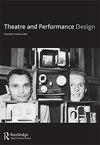聆听室:在潘潘的《所有的坠落》中体验场景
Q2 Arts and Humanities
引用次数: 0
摘要
本文探讨了舞台设计,特别是表演的视觉-听觉-空间元素,如何通过作为表演的指导元素或其主要意义来塑造观众的反应。本文以2011年在都柏林Abbey剧院上演的Pan Pan剧院的《All That Fall》为例,探讨了声音、灯光和空间设计如何利用观众的体现反应。结合深入的表演分析,本文将利用观众反馈和戏剧从业者访谈,以调查场景设计如何通过感知的积极前景来组织观众与表演的关系,并展示对贝克特作品的不断发展的戏剧参与/反应。本文章由计算机程序翻译,如有差异,请以英文原文为准。
The listening chamber: experiencing scenography in Pan Pan’s All That Fall
ABSTRACT This article explores how scenography, specifically the visual-aural-spatial elements of a performance, shapes the response of an audience by acting as either a guiding element to a performance or its primary meaning. Through the case study of Pan Pan Theatre’s All That Fall (2011) in the Abbey Theatre, Dublin, this article investigates how the sound, lighting and spatial designs exploit the audience’s embodied responses. In conjunction with in-depth performance analysis, this article will utilise audience feedback and theatre practitioner interviews in order to investigate how scenography organises the relationship of the audience to the performance through the active foregrounding of perception, as well as demonstrating the evolving theatrical engagements/responses to Beckett’s work.
求助全文
通过发布文献求助,成功后即可免费获取论文全文。
去求助
来源期刊

Theatre and Performance Design
Arts and Humanities-Visual Arts and Performing Arts
CiteScore
0.40
自引率
0.00%
发文量
14
 求助内容:
求助内容: 应助结果提醒方式:
应助结果提醒方式:


